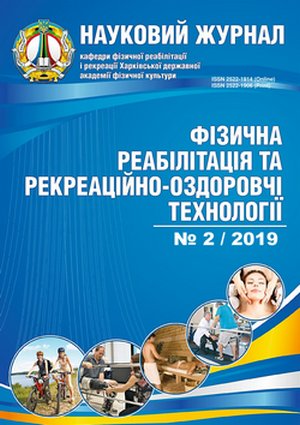Changes in muscle tone in 36-46 year olds after spine injuries under the influence of therapeutic physical education
DOI:
https://doi.org/10.15391/prrht.2019-4(2).05Keywords:
хребетно-спинномозкова травма, шийний відділ, лікувальна фізична культура, спастичність м’язів.Abstract
Abstract. Spinal cord injury is one of the most difficult problems of modern neurosurgery. According to statistics, there are about 3,000 people with this disease in Ukraine every year. The causes of cervical spinal cord injury are traffic accidents, domestic and industrial injuries. Therefore, the main task of doctors at the current stage is the creation of physical rehabilitation programs for the successful treatment and rehabilitation of this contingent of patients. The purpose of the study is to study the changes in muscle tone in persons of II mature age with spinal cord injury of the cervical region under the influence of therapeutic physical education. Material and methods: 27 people (10 women and 17 men) with this injury participated in the study. The age of the patients is 36-46 years. The degree of spasticity was determined according to the modified 6-point Ashforth spasticity scale. Results: All patients were divided into two groups: control (13 people) and main (14 people). The physical therapy classes developed by us contributed to the reduction of spasticity of the studied muscles. Thus, the level of spasticity of the calf and soleus muscles, adductor muscles, and quadriceps muscle in the subjects of the main group is two times lower than in the patients of the control group. Conclusions. Therefore, the results of our research indicate that physical therapy exercises contribute to the reduction of muscle spasticity.
References
Бісмак О. (2015) Особливості організації діяльності реабілітаційних закладів в Україні. Освітологічний дискус. №4(12), 45-49.
Богдановська Н.В. (2012) Сучасні технології в реабілітації хворих із спинномозковою травмою. Вісник Запорізького національного університету. №2(8), 117–124
Дзяк Л.А., Сальков М.М., Зорін М.О., Тітов Г.І. (2015) Актуальні питання організації надання медичної допомоги, діагностики та лікування бойової хребетної та хребетно-спинномозкової травми. Український нейрохірургічний журнал. № 1, 56-62.
Кобелєв С.Ю. (2004) Особливості створення індивідуальної програми фізичної реабілітації для осіб з пошкодженням спинного мозку. Теорія і практика фізичного виховання. № 3, 258-263.
Крук Б.Р. (2004) Визначення вихідного рівня показників рухової функції осіб з хребетно-спинномозковою травмою шийного відділу в післяопераційний період. Педагогіка, психологія та медико-біологічні проблеми фізичного виховання та спорт.. Х. №15, 70-74.
Крук Б., Рокошевська В., Білянський О., Герцик А. (2015) Особливості організації процесу фізичної реабілітації осіб із хребетно-спинномозковою травмою в умовах стаціонару. Спортивна наука України. №2(66), 17–21.
Крук Б. (2011) Особливості процесу фізичної реабілітації осіб з хребетно-спинномозковою травмою шийного відділу хребта. Бюлетень Української Асоціації фахівців фізичної реабілітації. №5.
Педаченко Є. Г., Іпатов А.В., Тарасенко О.М. (2012) Статистичний аналіз інвалідності при травмі хребта та спинного мозку. Запорізький медичний журнал. №6(75), 21–23.
Симонова І.А. (2000) Епідеміологія хребетно-спинномозкової травми і організація медичної допомоги постраждалим (Автореф. дис… канд. мед. наук). СПб.
Федорович О., Передерій А. (2017) Сучасний стан реабілітації осіб з травмами хребта та спинного мозку в Україні. Спортивна наука України. №3(79), 40-46.
Roy R.R., Harkema S.J., Engerton V.R. (2012) Basic concepts of activity-based interventions for improved recovery of motor function after spinal cord injury. Arch. Phys. Med. Rehabil. 93(9), 1487-1497.
Downloads
Published
Versions
- 2023-10-22 (2)
- 2023-10-22 (1)
Issue
Section
License
Copyright (c) 2021 А.С. Сулима, М.Д. Насальський, О.О. Здебський

This work is licensed under a Creative Commons Attribution 4.0 International License.

 Dear authors!
Dear authors!